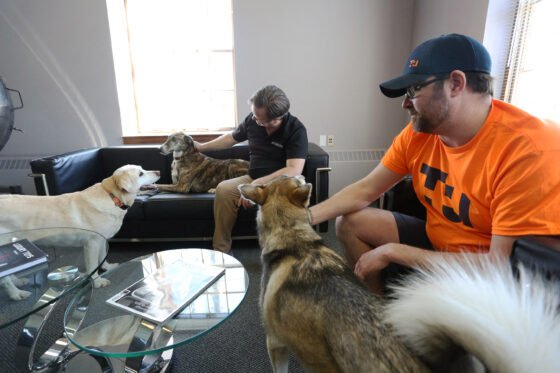
Daisy is on all fours and wags her tail when visitors come. Daisy oversees the wellbeing of the Tungsten Collaborative team. The dog, like many other pets, has the right to come to the office with her owner, who was working from home during the pandemic. The 12-year-old blond-haired Labrador rummages around the workspace for something to eat or play with.
Beside her, Delilah – a basset hound with long, drooping ears – approaches, as if seeking some attention, too. This Canadian design company, with a dozen employees in Ottawa, has other dogs such as Eevee the English Greyhound and Hudson, a German Shepherd puppy, who barks to be noticed.
Daisy is an “integral part” of the company. On the company’s website, she poses among the members of the team and is even entitled to a short biography. “Several of Dave’s (VP Design McMullin’s) greatest innovations came about on long walks alongside Daisy”the company writes, adding that the female dog matters “nine years of experience supporting the best designers”.
Return of activity
“We encourage people with pets to bring them” in the office, Bill Dicke, president of the Tungsten Collaborative, told AFP. “You develop this relationship with your pet at home and all of a sudden you go back to work, and they have to crate or roam the house alone for the day”regrets the 47-year-old manager, who thinks that this “Is not fair” for the animal.
He said the pandemic has made businesses more tolerant of pets at work. In the office kitchen, rows of bowls on the floor are used to water the dogs during the day. The latter sometimes sleep at the foot of chairs, chew on toys, or run to a bouncy ball in the hallway.
Adding Tungsten Collaborative to the Humane Society’s list of dog-friendly businesses has boosted business activity and increased staff productivity, Dicke said.
According to a recent Léger survey conducted for PetSafe, one in two Canadians (51%) support the idea of taking their dog into the office. This proposal is particularly appreciated by the youngest: 18% of employees aged 18 to 24 say they would change companies if their employer refused them this option.
Faced with the roughly 200,000 Canadians who have adopted a cat or dog during the pandemic, bosses who personally demand the return of their workers may be forced to consider easing.
“Relax”
For some employees such as Johan Van Hulle, 29, this new rule “a key factor in (his) decision” to join Tungsten last year. “Allowing dogs is a good indicator” of a company’s culture, AFP confirms Eevee’s master, who was looking for an environment “not too businesslike”.
Also in Ottawa, this time within the construction joint venture Chandos Bird, the designers of a nuclear research lab are visibly excited by the presence of Samson, a 10-year-old blond Yorkshire terrier. His master, Trevor Watt, did not want to leave him alone in his new home when he returned to the office in January.
Bringing him in would be a temporary solution. Not only did he adapt to office life, but he also won over his master’s colleagues, who now walk with Samson. “He likes to come to work”confides Trevor Watt, who appreciates it “to not have to worry about him”.
Her owner, Byron Williams, thinks petting a dog is a great way to… “decompress after a big meeting”. But the presence of man’s best friend at work can pose certain challenges, for example for employees who are allergic to animals or who are afraid of animals. Samson stays on the line when Trevor Watt’s coworker, terrified of dogs, is nearby.
Some employees of other companies, interviewed by AFP, also complained about carpet stains, spontaneous barking and hair ubiquitous.
AFP